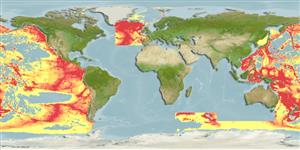Colossendeis colossea Wilson, 1881
| Native range | All suitable habitat | Point map | Year 2050 |

|
| This map was computer-generated and has not yet been reviewed. |
| Colossendeis colossea AquaMaps Data sources: GBIF OBIS |
Upload your photos
Google image |
No photo available for this species.No drawings available for Colossendeidae.
Google image |
No photo available for this species.
Classification / Names Common names | Synonyms | CoL | ITIS | WoRMS
Pycnogonida | Pantopoda | Colossendeidae
Environment: milieu / climate zone / depth range / distribution range Ecology
Benthic; depth range 425 - 5219 m (Ref. 116374), usually 1000 - 2500 m (Ref. 1797). Tropical
Distribution Countries | FAO areas | Ecosystems | Occurrences | Introductions
Arctic Ocean, Northeast Atlantic, Indo-Pacific and the Antarctic (Pan oceanic). Tropical to polar.
Length at first maturity / Size / Weight / Age
Maturity: Lm ? range ? - ? cm Max length : 70.0 cm LS male/unsexed; (Ref. 2153)
Short description Morphology
One of the largest species of the genus, many specimens known with leg spans more than 50 cm. Proboscis long, very swollen medially, with smaller swelling distally, without curve of any form. Palp much longer than proboscis, fifth segment almost as long as third, seventh only slightly shorter, distal three segments subequal in length. Legs conspicuously long and slender. Tarsus about 0.4 longer than propodus, claw about half propodal length (Ref. 9). Largest species of genus known in Arctic.
Legs extremely long, leg span up to 70 cm. Proboscis about 1.5 times longer than trunk, medially inflated; narrowing proximally and distally, with slightly swollen oral surface, not conspicuously curved. Distal palp 3 segments subequal in length. Tarsus about 1.5 times longer than propodus, claw slightly less than half propodal length (Ref. 2153, p. 24).
Minimum depth from Ref. 117242. Bathyal (Ref. 19) to abyssal (Ref. 19 and 169). Feeds on anemones (Ref. 121217).
Life cycle and mating behavior Maturity | Reproduction | Spawning | Eggs | Fecundity | Larvae
Members of the class Pycnogonida are gonochoric and sexually dimorphic. During copulation, male usually suspends itself beneath the female. Fertilization occurs as the eggs leave the female's ovigers. Males brood the egg masses until they hatch. Life cycle: Eggs hatch into protonymphon larva then to adults.
Main reference
References | Coordinator | Collaborators
Child, C.A. 1998. (Ref. 9)
IUCN Red List Status (Ref. 130435)
CITES status (Ref. 108899)
Not Evaluated
CMS (Ref. 116361)
Not Evaluated
Threat to humans
Human uses
| FishSource |
Tools
More information
Internet sources
BHL | BOLD Systems | CISTI | DiscoverLife | FAO(Publication : search) | Fishipedia | GenBank (genome, nucleotide) | GloBI | Gomexsi | Google Books | Google Scholar | Google | PubMed | Tree of Life | Wikipedia (Go, Search) | Zoological Record
Estimates based on models
Preferred temperature
(Ref. 115969): 1.8 - 4.5, mean 2.7 (based on 4032 cells).
Price category
(Ref. 80766):
Unknown.


